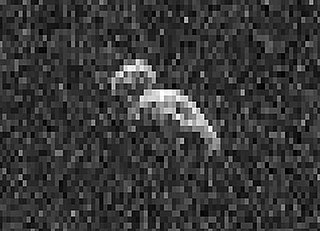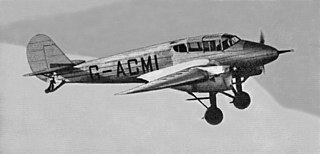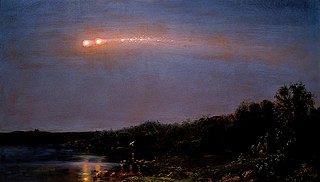
A near-Earth object (NEO) is any small Solar System body with an orbit around the Sun that can bring it near the Earth. By astronomical convention, a small natural Solar System body is a NEO if its closest approach to the Sun (perihelion) is less than 1.3 astronomical units (AU). This definition applies to the object's orbit, rather than its current position, thus an object is considered a NEO even if it is far from making a close approach of Earth. If a NEO's orbit crosses the Earth's orbit, and the object is larger than 140 meters (460 ft) across, it is considered a potentially hazardous object (PHO). Most known PHOs and NEOs are asteroids, but about 0.35% are comets.

A meteoroid is a small rocky or metallic body in outer space. Meteoroids are distinguished as objects significantly smaller than asteroids, ranging in size from grains to objects up to a meter wide. Objects smaller than meteoroids are classified as micrometeoroids or space dust. Most are fragments from comets or asteroids, whereas others are collision impact debris ejected from bodies such as the Moon or Mars.

Vostok was a family of rockets derived from the Soviet R-7 Semyorka ICBM and was designed for the human spaceflight programme. This family of rockets launched the first artificial satellite and the first crewed spacecraft (Vostok) in human history. It was a subset of the R-7 family of rockets.

The Meteor spacecraft are weather observation satellites launched by the Soviet Union and Russia. The Meteor satellite series was initially developed during the 1960s. The Meteor satellites were designed to monitor atmospheric and sea-surface temperatures, humidity, radiation, sea ice conditions, snow-cover, and clouds. Between 1964 and 1969, a total of eleven Soviet Union Meteor satellites were launched.

The Blackburn B-1 Segrave was a 1930s British twin-engine four-seat touring aircraft built by Blackburn Aircraft.
The low-rate picture transmission (LRPT) is a digital transmission system, intended to deliver images and data from an orbital weather satellite directly to end users via a VHF radio signal. It is used aboard polar-orbiting, near-Earth weather satellite programs such as MetOp and NPOESS.

A heavily modified Gloster Meteor F8 fighter, the "prone position/prone pilot" Meteor, was used by the Royal Air Force in 1954 and 1955 to evaluate the effects of acceleration/inertia-induced forces while flying in a prone position. Along with the Reid and Sigrist R.S.4 "Bobsleigh", the Gloster Meteor was engaged in a proof-of-concept experimental programme that proved in practice that the difficulties in rearward visibility and ejection outweighed the advantages of sustaining higher g effects.

The AVIA FL.3 was an Italian two-seat cabin monoplane designed and built by Azionaria Vercellese Industrie Aeronautiche (AVIA) who were later taken over by Lombardi in 1947.

Weather satellite pictures are often broadcast as high-resolution picture transmissions (HRPTs), color high-resolution picture transmissions (CHRPTs) for Chinese weather satellite transmissions, or advanced high-resolution picture transmissions (AHRPTs) for EUMETSAT weather satellite transmissions. HRPT transmissions are available around the world and are available from both polar and geostationary weather satellites. The polar satellites rotate in orbits that allow each location on Earth to be covered by the weather satellite twice per day while the geostationary satellites remain in one location at the equator taking weather images of the Earth from that location over the equator. The sensor on weather satellites that picks up the data transmitted in HRPT is referred to as an Advanced Very High Resolution Radiometer (AVHRR).
An atmospheric reanalysis is a meteorological and climate data assimilation project which aims to assimilate historical atmospheric observational data spanning an extended period, using a single consistent assimilation scheme throughout.

An Earth-grazing fireball is a fireball, a very bright meteor that enters Earth’s atmosphere and leaves again. Some fragments may impact Earth as meteorites, if the meteor starts to break up or explodes in mid-air. These phenomena are then called Earth-grazing meteor processions and bolides. Famous examples of Earth-grazers are the 1972 Great Daylight Fireball and the Meteor Procession of July 20, 1860.

Elektro–L is a series of meteorological satellites developed for the Russian Federal Space Agency by NPO Lavochkin. The first satellite, Elektro-L No.1, was launched on 2 January 2011. It is the first Russian weather satellite that successfully operates in geostationary orbit, and is currently the second operational Russian weather satellite. The satellites have a mass of about 1620 kg and are designed to operate for 10 years each. They are capable of producing images of the Earth's whole hemisphere in both visible and infrared frequencies, providing data for climate change and ocean monitoring in addition to their primary weather forecasting role.

Kosmos 2430 was a Russian US-K missile early warning satellite which was launched in 2007 as part of the Russian Space Forces' Oko programme. The satellite was designed to identify missile launches using optical telescopes and infrared sensors.

The Chelyabinsk meteor was a superbolide that entered Earth's atmosphere over the southern Ural region in Russia on 15 February 2013 at about 09:20 YEKT. It was caused by an approximately 18 m (59 ft) diameter, 9,100-tonne (10,000-short-ton) near-Earth asteroid that entered the atmosphere at a shallow 18.3 ± 0.4 degree angle with a speed relative to Earth of 19.16 ± 0.15 kilometres per second. The light from the meteor was briefly brighter than the Sun, visible as far as 100 km (60 mi) away. It was observed in a wide area of the region and in neighbouring republics. Some eyewitnesses also reported feeling intense heat from the fireball.

BLITS (Ball Lens In The Space) is a Russian satellite launched on September 17, 2009, as a secondary payload on a Soyuz-2.1b/Fregat, from the Baikonur Cosmodrome in Kazakhstan. The satellite is totally passive and spherical, and is tracked using satellite laser ranging (SLR) by the International Laser Ranging Service. The design of BLITS is based on the optical Luneburg lens concept. The retroreflector is a multilayer glass sphere; it provides uniform reflection characteristics when viewed within a very wide range of angles, and can provide a cross-section sufficient for observations at low to medium orbit heights. A similar design was already tested on a smaller laser reflector carried on board of the METEOR-3M spacecraft launched on December 10, 2001.

Meteor-3M No.1 was the first and only of the Meteor-3M series polar-orbiting weather satellites. It was launched on 10 December 2001 at 17:18:57 UTC from the Baikonur Cosmodrome in Kazakhstan. The satellite is in a Sun-synchronous orbit with an ascending node time of about 9AM.

Meteor-M No.1 was the first of the Russian Meteor-M series of polar-orbiting weather satellites. It was launched on a Soyuz-2.1b rocket with a Fregat upper stage on 17 September 2009. Meteor-M No.1 was the designated replacement for Meteor-3M No.1, and had a design life of 5 years. In November 2014, Russian officials announced the termination of the mission after a failure of the onboard attitude control system.

The Vostochny Cosmodrome Site 1S is a launch complex at the Vostochny Cosmodrome in Russia. It consists of a single pad for use by the Soyuz-2 launch vehicles.

Meteor-M No.2-1, was a Russian satellite, part of Meteor-M series of polar-orbit weather satellite. It was launched using Soyuz-2.1b rocket with a Fregat upper stage on 28 November 2017; the satellite failed to separate from the Fregat and communication was later lost.
INSAT-2C was an Indian geostationary communications spacecraft. It is ISRO's third indigenous communications satellite.

















